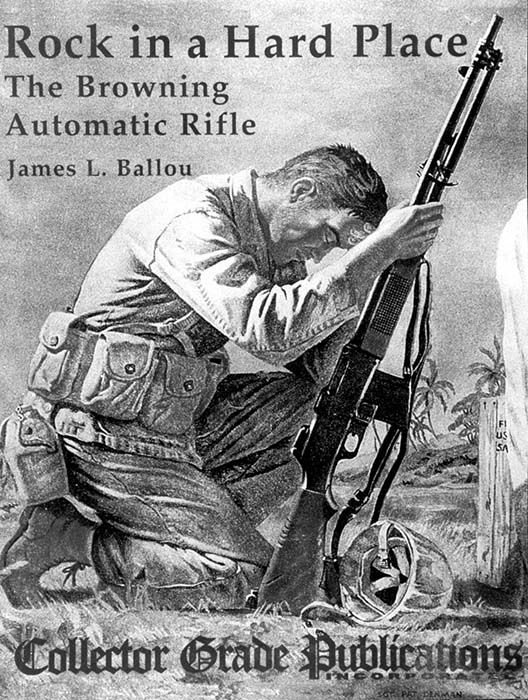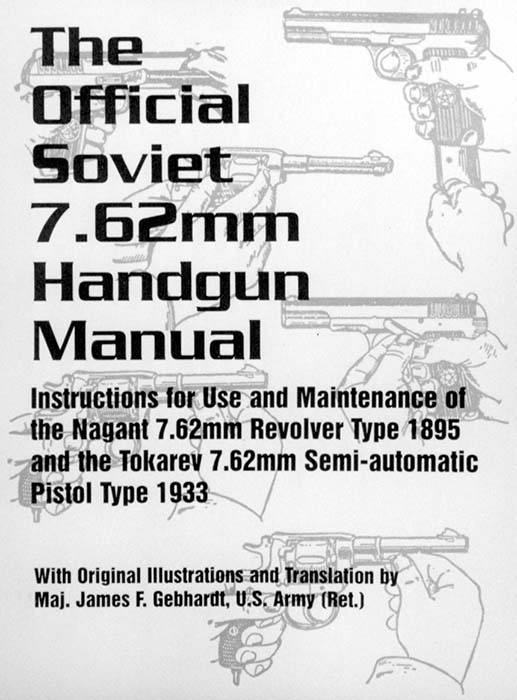By David M. Fortier
Rock In A Hard Place: The Browning Automatic Rifle
by James L. Ballou
Collector Grade Publications Inc.
P.O. Box 1046
Cobourg, Ontario Canada K9A 4W5
905-342-3434
WWW.COLLECTORGRADE.COM
ISBN 0-88935-263-1
469 pages, profusely illustrated
$79.95
Reviewed By David M. Fortier

For the serious student of firearms accurate and comprehensive works on the weapons in question are a must. When it comes to “accurate and comprehensive” Collector Grade Publications leads the way. All the other works from this publishing house have been most impressive in their content. This latest offering is no exception, it is superbly researched, written, and illustrated.
Covering the Browning Automatic Rifle, Mr. Ballou offers a comprehensive in-depth look at the B.A.R. from concept to current semi-auto copies. Starting with John Moses Browning himself, the book slowly unwinds this devastating gun’s long history. From gearing up for World War I, into the trenches, post war development, gangster use during the Roaring 20’s, World War II, Korea, and Vietnam this book covers it all. It offers a looks at the weapon itself in all its different models and variations along with their ancillary gear. The changes made over time to “improve” the B.A.R. as it gained weight are well documented. But this book offers much more than that. It offers substantial insight into the men who carried, fought with, and sometimes died with the B.A.R.. Combat reports abound, as do comments by users about what they thought of the weapon, and how quickly they tossed the bipod into the nearest ditch. Foreign variations are not ignored, and even models for the Police and FBI are covered, as are modifications performed by such notorious criminals as Clyde Barrows.
To be frank, $80 is a lot of cash for a book. However this is not your run of the mill firearms book. Extremely well illustrated it covers the B.A.R. from A to Z. If you want information on the Browning Automatic Rifle, this is your one stop shopping. I highly recommend this work, the amount of research that went into putting it together must have been staggering. If you love B.A.R.’s you’ll love this book.
1900 Luger, US Test Trials
By Michael Reese II
Published by Pioneer Press
Union City, Tennessee 38261
Library of Congress # 71-117532
Price $6.00 plus $4.50 shipping and handling
105 pages
Reviewed by Stephen Stuart
One of the most sought after variations of the Luger handgun is the 1901 US test specimens. Early in the spring of 1901 two test Lugers were bought and tested through the United States Board of Ordnance and Fortifications under Lieutenant Colonel Frank H. Phipps. After an initial test of these two pistols, he ordered a field trial to be conducted. This field trial would include a thousand model 1900 pistols, 200,000 round of ammunition and extra magazines. The first shipment arrived in October 1901.
This test trial of the Luger handgun came up with mixed results. Some commands like the pistol, others did not. These trials proceeded until finally DWM, the manufacturer of the Luger handgun stopped the trials. Some arms historians have pondered the question why they stopped the trials. Many believe that DWM would no longer put up with the requests of the US Ordnance Department. Still some say it was because DWM knew that the Luger was going to be accepted by the German Military in large numbers. In Mr. Reese’s book, 1900 Luger, he provides insight into the trials of the 1900 Luger by providing the test results of these pistols for the reader to discern what is fact and fiction. Included in the test are photos of actual surviving specimens and some of the holsters specially produced for them by Rock Island Arsenal.
Even though the photos are sometimes of poor quality and the Xeroxing of documents are a little fuzzy, the book as a whole is well worth the six bucks. It gives the reader insight into the minds of the Luger testers almost ninety years ago in their own words. It is also a wonderful piece of reference by providing the serial numbers of all the pieces actually tested. Even with some of the problems in printing I found this a worthy edition to my reference library.
The Official Soviet 7.62 mm Handgun Manual
Translation by
Major James F. Gebhardt,
U.S. Army (Ret.)
Paladin Press
P.O. Box 1307
Boulder, CO 80306
1-800-392-2400
ISBN 0-87364-907-9
$20.00 plus S&H
104 pp
Reviewed by David M. Fortier

Underneath the title it says “Instructions for use and maintenance of the Nagant 7.62 mm Revolver Type 1895 and the Tokarev 7.62 mm Semi-Automatic Pistol Type 1933” and that’s exactly what this book is. Here is a translation of the original Soviet handgun manual for these two combat pistols. The Nagant served from its adoption in 1895 to the end of the Great Patriotic War in front line Soviet service. The Tokarev served from its adoption in 1930, through its simplification in 1933, until it was replaced by the PM Makarov in the early 1950’s. Like all Soviet weapons these two handguns earned a reputation for being tough and reliable no matter the abuse they were subjected to.
Now with large quantities of these handguns in the United States there is an English translation of the Soviet manual available to the American shooter. Piece by piece identification and explanation of each parts function is given. Step by step disassembly and then assembly of the Nagant and Tokarev is given. Trouble shooting and repair work is taught. Accessories and cleaning equipment are covered, as well as ammunition. The Soviet military method of sighting the weapons in is detailed, as well as cleaning, and maintenance. The deployment of the handguns in combat is explained, not only with and without the use of cover, but even from horseback!
Anyone who owns a Nagant or Tokarev will find this manual informative and useful. The drawings (original Soviet)are excellent. The translation is extremely good and reads perfectly. Now you can have the information directly from the source on how to use and maintain your Nagant or Tokarev pistol.
| This article first appeared in Small Arms Review V4N9 (June 2001) |











